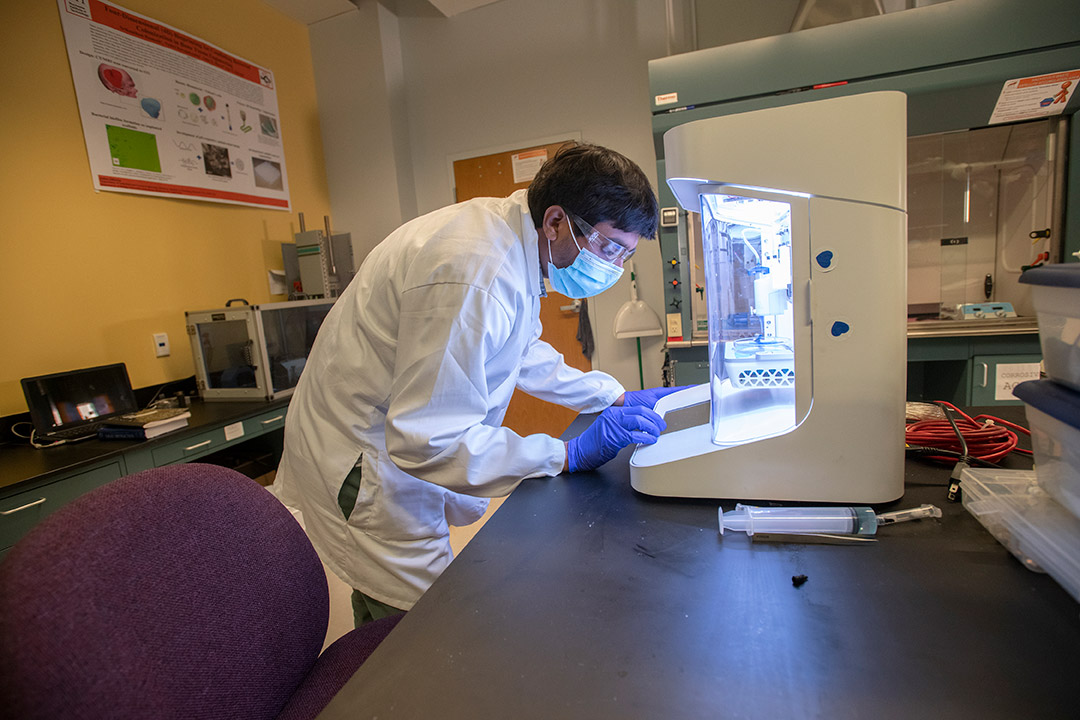Working together, but safely distant, in RIT’s research labs
Laboratories are starting to open and work is resuming after several months of down time
A. Sue Weisler
Engineering doctoral students Srikanthan Ramesh and Jakob Hamilton, foreground, assisted with enhancing plans for physical distancing and cleaning protocols in the Interdisciplinary Manufacturing Engineering Laboratory in Institute Hall.
Student-researchers Srikanthan Ramesh and Jakob Hamilton resumed work in Professor Iris Rivero’s Interdisciplinary Manufacturing Engineering and Design (IMED) Lab in Institute Hall in mid-June. The two doctoral students assisted with implementing some of the new COVID-19 safety protocols for the lab, which develops biomaterials and material systems to help restore damaged tissue.
IMED is one of several RIT research labs ramping up work after several months of down time due to COVID-19. With the approval to reopen and prepare for fall classes, faculty-researchers have put in place some of the recommended guidelines for lab usage—from occupancy to cleaning protocols. The majority are based on guidelines from the recently published RIT Ready Plan. Some of the finer points have been enhanced by those working in the lab.
A. Sue Weisler
Srikanthan Ramesh, pictured above, works with Iris Rivero, professor and department head of Industrial and Systems Engineering, creating 3D-printed platforms to produce bone and tissue replacements. With new access and cleaning protocols in place due to COVID-19, the work is able to continue with some adjustments.
“The markings on the floor are at least one example of where we used the guidelines Dr. Rivero had set out on the lab’s original application. This was initially 6-feet of space,” said Hamilton. “But actually, looking at this room, it made more sense to divide it into larger regions. The area where the hood is, usually there will only be one person here. It just made more sense to make it into larger regions based on groups of equipment rather than straight, 6-foot sections.”
Faculty-researchers and facilities managers were asked to submit documentation to RIT’s vice president for research about work being done in campus teaching labs and research centers, the equipment necessary, and authorized personnel. Once initial steps are approved, researchers can add more specific steps such as scheduling to manage use and cleaning protocols to ensure safety.
Upon arriving at the lab, Ramesh and Hamilton use a QR code to submit entry time; they follow a similar procedure when they leave. This is also required for all guests and the data will be used for contact tracing if needed.
IMED consists of several doctoral and graduate students, and they have worked among themselves to put in place a work schedule. With the recommendation that there be only two students in the lab at a time, the schedule provides a structure for each of the students to manage the scope of their project work.
“If someone has an experiment, we update the log the day before, so we don’t come in on the same day. I plan my experiments for a later time,” said Ramesh, who has been working with Rivero on creating 3D-printed platforms to produce bone and tissue replacements. She is the department head of industrial and systems engineering in RIT’s Kate Gleason College of Engineering.
Primary areas in the lab include a hooded test area with adjoining equipment, several rapid prototyping and bioprinters, a centrifuge, x-ray equipment, and specimen storage areas. These areas are marked with the now-familiar physical distancing floor tape and signage.
Cleaning is a regular aspect of research labs to ensure that developing specimens are not contaminated.
“The guidelines are pretty easy to implement with additional PPE and by making sure you are more aware of your surroundings. I think a lot of this just extends past the laboratory to what we actually do in society now,” said Hamilton, whose work is on the development of aluminum composite powder and the testing of 3D-printed materials to better understand possible stressed or weakened materials.
There are some aspects of the lab environment that still need to be worked out, specifically in the area of interactions with collaborators. For the IMED lab, some of the 3D-printed scaffolds that include live cells require testing in clinical settings.
“The one problem we are facing now is we work a lot with the University of Rochester, and they help us with cell studies. That is all super-restricted, especially now,” said Ramesh, who added that although some of this more involved testing has stopped, it is only temporary, and the team is exploring alternatives with partners to continue its development processes.











